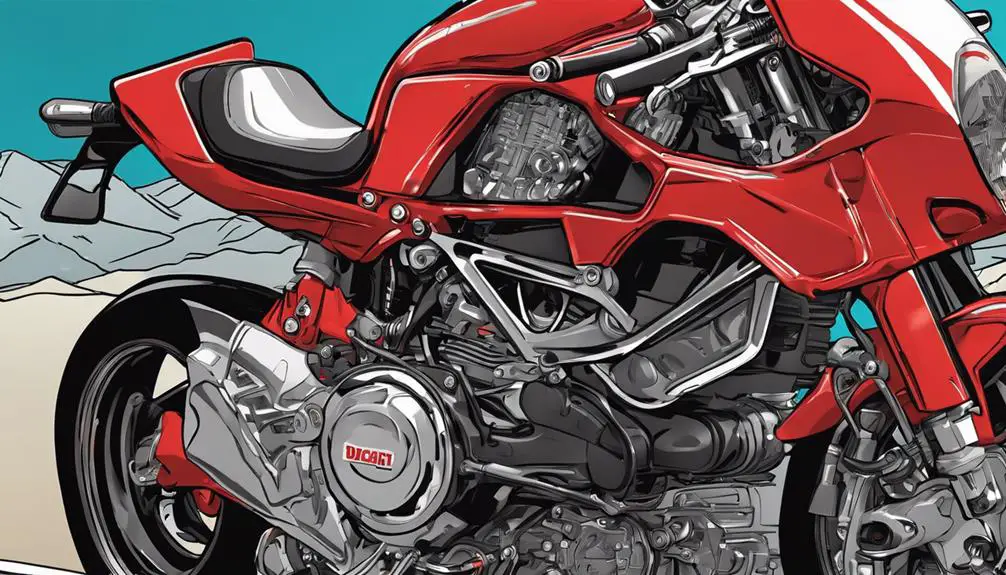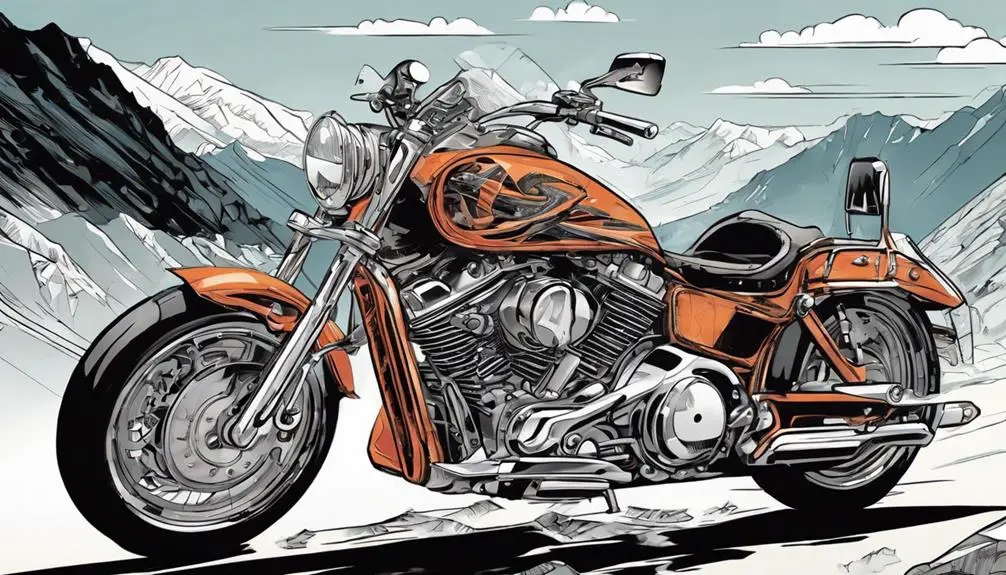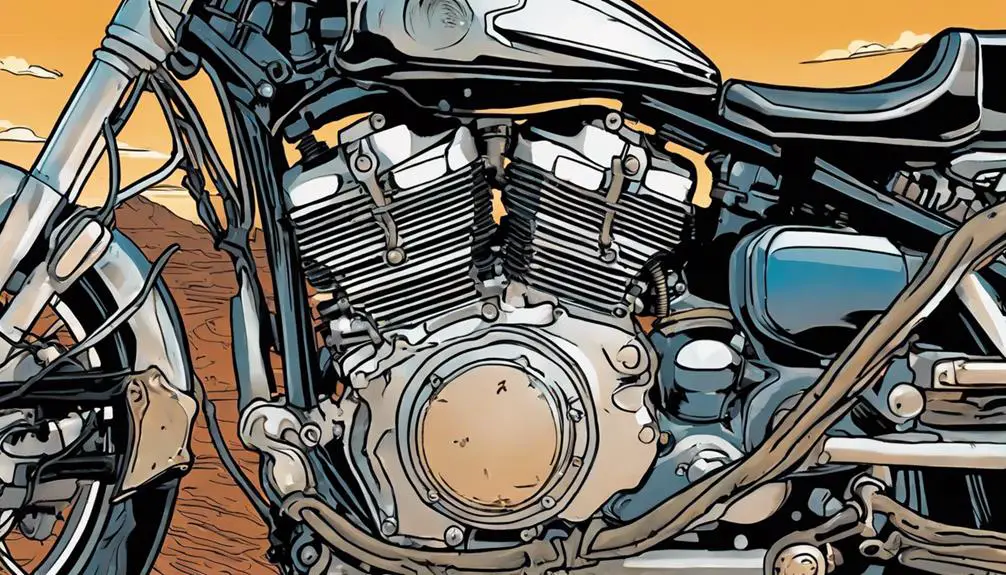It's a coincidence that you stumbled upon this topic just as you're gearing up for your next long ride. When it comes to touring motorcycles, knowing the engine specs can make a world of difference in your experience on the road. From engine displacement to fuel efficiency, each aspect plays a pivotal role in how well your bike performs over extended journeys. But what specific metrics should you prioritize to guarantee a smooth, enjoyable ride? Let's explore those critical specifications that could transform your next adventure.
Key Takeaways
- Ducati engines feature an L-twin configuration, providing powerful performance and enhanced stability for touring.
- Displacement ranges from 803cc to 1262cc, catering to diverse riding styles and preferences.
- Electronic fuel injection systems optimize power output while minimizing emissions for better efficiency.
- Regular maintenance, including oil changes and air filter inspections, ensures peak engine performance and longevity.
Ducati Engine Overview

Ducati engines are renowned for their powerful performance and distinctive L-twin configuration, making them a favorite among motorcycle enthusiasts. When you hop onto a Ducati, you immediately feel the thrill of its robust power delivery. This unique engine design creates a low center of gravity, enhancing stability and control on the road. You'll notice how effortlessly the bike accelerates, giving you that exhilarating sense of freedom as you ride.
The sound of a Ducati engine is unmistakable, resonating with a deep and throaty growl that stirs your soul. It's not just about getting from point A to point B; it's about the journey, the rush, and the pure joy of riding. Each twist of the throttle releases a wave of adrenaline, connecting you to the machine and the open road.
Ducati understands the desires of riders like you, who crave not just speed but an emotional experience. The combination of precision engineering and Italian artistry means you're not just riding a motorcycle; you're embracing a lifestyle. With every ride, you break free from the mundane, discovering new horizons and redefining what it means to feel alive.
Key Engine Specifications
Understanding the key engine specifications of a Ducati can enhance your appreciation for the engineering that powers these iconic machines. The heart of every Ducati is its Desmodromic valve system, which guarantees precise timing and peak performance. You'll notice the unique L-twin configuration, offering a thrilling balance of power and torque.
When you check out the displacement, you'll see numbers ranging from 803cc to 1262cc, depending on the model. This range gives you the flexibility to choose between spirited rides and long-distance cruising. Pay attention to the compression ratio, too; a higher ratio can lead to greater efficiency and acceleration, making your ride feel even more exhilarating.
Don't overlook the fuel system; Ducati's use of electronic fuel injection maximizes power while minimizing emissions, granting you the freedom to roam without guilt. Finally, consider the cooling system—most models feature liquid cooling, guaranteeing that your engine runs smoothly even under the most demanding conditions.
These specifications aren't just numbers; they represent the freedom and exhilaration you'll experience on the open road. Embrace the engineering, and let it guide you on your adventures.
Performance Metrics

Performance metrics reveal how well a motorcycle can deliver power and acceleration, giving you a clear sense of its capabilities on the road. When you're on the open highway, you want a bike that responds to your every twist of the throttle, and metrics like horsepower and torque are vital.
Horsepower measures how much power your engine produces, while torque tells you how much pulling force it can exert. You'll want to take into account the power-to-weight ratio, too. A lighter bike with ample horsepower accelerates faster, letting you feel that rush of freedom.
Checking the 0-60 mph time gives you an idea of how quickly you can take off from a standstill, essential for merging into traffic or zipping past slower vehicles. Don't overlook braking performance either; it's just as important as acceleration.
A motorcycle that can stop on a dime enhances your confidence, allowing you to ride with a sense of security. Ultimately, understanding these performance metrics helps you choose a touring motorcycle that not only meets your needs but fuels your desire for adventure and liberation on every ride.
Fuel Efficiency Insights
When it comes to fuel efficiency, engine size plays an essential role in how far you can go on a tank.
You'll also notice that the riding conditions you encounter can greatly influence your bike's performance.
Plus, regular maintenance is key to ensuring your motorcycle runs at its most efficient.
Engine Size Impact
The size of your motorcycle's engine directly influences its fuel efficiency, affecting how far you can travel on a tank.
Larger engines often deliver more power, but they can also consume more fuel. If you're seeking the freedom of the open road, striking the right balance is essential. For instance, a 1000cc engine might give you that exhilarating acceleration, but it may require more frequent stops at the pump.
On the other hand, a smaller engine, like a 600cc, can offer impressive fuel efficiency, allowing you to ride longer distances without the constant need to refuel.
This efficiency can enhance your journey, letting you explore more and worry less about gas stations interrupting your adventure.
Riding Conditions Influence
Riding conditions can significantly impact your motorcycle's fuel efficiency, with factors like terrain, weather, and traffic all playing vital roles.
When you're cruising along a smooth highway, your engine can perform at its best, leading to better mileage. However, if you find yourself winding through hilly terrain, your bike will consume more fuel as it works harder to climb those inclines.
Weather also plays an important part. Riding against strong winds can reduce your bike's aerodynamics, causing your engine to labor more and drain fuel faster. Conversely, a calm day lets you glide effortlessly, letting your motorcycle sip fuel rather than guzzle it.
Traffic conditions shouldn't be overlooked either. Stop-and-go scenarios can wreak havoc on your fuel efficiency, forcing your engine to constantly adjust its output. Smooth, uninterrupted rides allow for a more efficient fuel burn.
Maintenance and Efficiency
Regular maintenance is essential for optimizing your motorcycle's fuel efficiency, ensuring that every component functions smoothly and effectively. When you keep your bike in top shape, you not only enhance your ride but also liberate yourself from unnecessary fuel costs.
Start with regular oil changes; clean oil reduces friction, allowing the engine to run efficiently.
Next, check your air filter. A clogged filter restricts airflow, making your engine work harder and guzzle more gas. Keeping tires properly inflated is vital too. Under-inflated tires create extra drag, forcing your engine to burn more fuel.
Don't forget about spark plugs. Worn plugs can lead to incomplete combustion, which wastes fuel and power. Make it a habit to inspect and replace them regularly.
Lastly, aim for a smooth riding style. Rapid acceleration and hard braking can hurt your fuel efficiency. Instead, embrace gradual acceleration and deceleration.
Common Issues

Many riders encounter common issues with motorcycle engines that can affect performance and reliability. One prevalent problem is overheating, which often results from low coolant levels or a malfunctioning radiator. If you notice your engine temperature rising, it's essential to address it quickly to avoid serious damage.
Another common issue is poor fuel efficiency, usually caused by clogged fuel injectors or a dirty air filter. This not only impacts your wallet but can also hinder your freedom on the open road. You want to ride without constantly worrying about refueling.
Ignition problems can also leave you stranded. Faulty spark plugs or a weak battery can prevent your bike from starting. Regular checks can help you ride freely without the anxiety of unexpected breakdowns.
Lastly, unusual noises from the engine can signal bigger issues, such as worn bearings or insufficient lubrication. Pay attention to these sounds; they're your bike's way of communicating its needs.
Maintenance Tips
Keeping your motorcycle engine in top shape requires consistent maintenance to prevent issues down the road. You don't want to be stranded on the side of the road when freedom calls. By staying proactive with your bike's care, you can embrace the open road without worries.
Here are some essential maintenance tips to keep your engine roaring:
- Check the Oil Regularly: Verify you're using the right type and level of oil. Change it as recommended to keep everything lubricated.
- Inspect the Air Filter: A clean air filter boosts performance. Clean or replace it when it's dirty.
- Monitor Tire Pressure: Properly inflated tires improve safety and handling. Check them before each ride.
- Examine the Battery: Look for corrosion and verify connections are tight. A strong battery means fewer surprises.
Frequently Asked Questions
What Are the Best Aftermarket Upgrades for Ducati Engines?
When you're looking to enhance your Ducati engine, consider upgrading the exhaust system for improved airflow and sound.
A high-performance air filter can increase horsepower, while a re-mapping of the ECU guarantees your bike runs smoothly with these changes.
Don't overlook suspension upgrades either, as they can greatly enhance handling.
Finally, investing in lightweight wheels can reduce inertia, giving you a more responsive ride.
These upgrades can truly elevate your biking experience!
How Does Ducati's Engine Compare to Other Touring Motorcycles?
You might've heard that Ducati engines are unparalleled in power and performance, but how do they stack up against other touring motorcycles?
While Ducati offers exhilarating speed and a unique character, you'll find that many touring bikes prioritize comfort and stability over sheer power.
If you seek liberation on the open road, consider what you value most: the thrill of Ducati's raw energy or the smooth reliability of traditional touring engines.
What Is the Average Lifespan of a Ducati Motorcycle Engine?
The average lifespan of a Ducati motorcycle engine typically ranges from 30,000 to 60,000 miles, depending on how you ride and maintain it.
If you're diligent with regular servicing and use quality oil, you can push that lifespan even further.
Remember, a well-loved engine can offer you thrilling rides for years.
Are There Specific Oils Recommended for Ducati Engines?
When you're tearing down the open road, your Ducati deserves the best oil to keep it purring like a wild stallion.
Ducati often recommends synthetic oils like Motul 7100 or Shell Advance 4T for peak performance.
These oils guarantee your engine stays cool and runs smoothly, letting you chase freedom without a hitch.
How Does Riding Style Affect Ducati Engine Performance?
Your riding style greatly affects your Ducati's performance.
If you ride aggressively, you'll notice quicker acceleration and sharper handling, but you might compromise fuel efficiency.
Smooth, controlled riding promotes better engine longevity and a more comfortable experience.
It's all about balance—pushing your bike hard can release its potential, but being gentle can maintain its health.
Ultimately, your approach to the road shapes how your Ducati thrives under your command.
Conclusion
In the world of touring motorcycles, the right engine specs can make or break your adventure.
You've learned about the power of Desmodromic valves and the thrill of varying displacements.
But are you ready to hit the open road equipped with this knowledge?
As you prepare for your next journey, remember that understanding performance metrics and maintenance tips can keep you safe and exhilarated.
The open road awaits—will you seize the ride or let it pass you by?